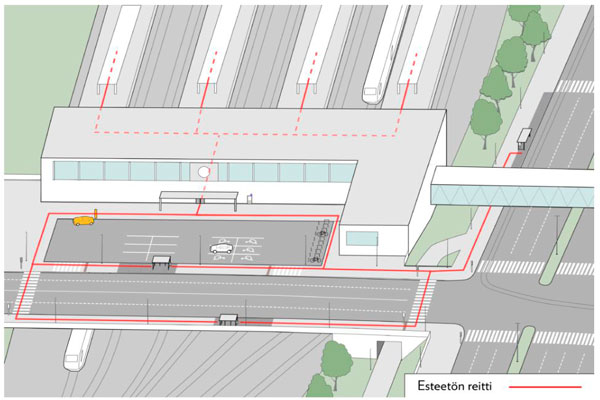Nationwide guidelines on buildings
On this page
- Design guidelines for accessible rail station infrastructure
- ESKEH mapping method
- Guide on accessible toilets and washrooms
Design guidelines for accessible rail station infrastructure
SUJUVA is a set of visualised accessibility regulations, guidelines and recommendations for designing accessible rail station infrastructure. It benefits designers, developers and maintenance providers alike. The objective is to provide straightforward and user-friendly visualised accessibility guidance to make it easier for designers to find the most effective accessibility solutions and to help maintenance providers to keep the infrastructure accessible at all times.

Rail station infrastructure is subject to special accessibility requirements and encompasses the metro or train station itself, including any buildings, as well as accessible routes to the nearest public transport connections, pick-up and drop-off points, and car parks.
ESKEH mapping method
Accessibility mapping is a tool for assessing the accessibility of an environment. The built-environment accessibility mapping method (ESKEH) was created in 2007–2009 as a joint nationwide project and updated by the Finnish Association of People with Physical Disabilities (ESKE) in 2018.
The method is intended for the mapping of buildings and their outdoor areas. It provides information on how well the accessibility criteria are fulfilled. This can be used to plan repairs and alterations.
The method includes mapping forms and a guide for the mapping process (link in Finnish). The ESKEH criteria are based on the accessibility regulations, guidelines and recommendations. A mapper uses these forms to gather information about a location and writes a report, describing the current state of accessibility and any deficiencies, and suggesting measures for improving accessibility.
The accessibility mappers are trained by the Finnish Association of People with Physical Disabilities’ accessibility centre, ESKE. Additionally, a few universities of applied sciences provide accessibility mapper training by using the ESKEH method.
In addition to that, another mapping method, Luonto-ESKEH, was developed in 2014 for mapping nature trails.
Guide on accessible toilets and washrooms
Accessible toilets and washrooms are part of a functioning accessibility chain of every building. They are vital to some users, while also serving all other building users. Having no accessible toilet may make it difficult or even impossible to use an otherwise functional building and the services it provides. In order for a person with reduced mobility or functional impairment to be able to live independently and receive assistance at home, they must have an accessible toilet and washroom.
The guide aims to help builders take the new accessibility requirements into account when constructing toilets and washrooms. The guide contains accessibility principles and good practices. The guidelines apply to the toilets and washrooms in ordinary homes, care home units and assisted housing units, as well the public accessible toilets and the related signs inside the buildings. Good planning can ensure that, in addition to compliance with the regulations, the details in toilets and washrooms are also functional and comfortable to use.